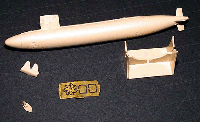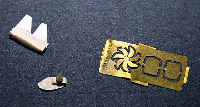
Reviewed by Vladimir Yakubov

|
A total of 37 Sturgeon class subs were built from 1963 until 1975. They made up the backbone of the US SSN fleet throughout the cold war with the last sub of the class retiring in 2004. Several submarines of the class were converted into the special ops boats with the addition of the compartments for the SEALs and the special reconnaissance equipment. Two were used to test various different propulsion systems. As the class that took on itself the brunt of the cold war, submarines of the Sturgeion class were involved in various interested missions and incidents during their careers. The most famous mission was when the USS Parche SSN-683 to tap the Soviet underwater cables from Kamchatka to the mainland in 1979. The tap went undetected for a number of years until a disaffected member of the NSA sold the information about it to the Soviets, who recovered the device (which is now on display at one of the Moscow museums). There were several underwater collisions involving the submarines of the class. On June 20th, 1970 USS Tautog SSN-639 collided with Soviet Echo II class SSGN K-108 underwater near Petropavlovsk-Kamchatskii while that sub was performing anti-submarine evasion maneuver called by the Americans "crazy Ivan". The collision was very violent (USS Tautog returned to base with a piece of the K108 screw imbedded in its sail) and for a long time in the west it was thought that the Soviet submarine had sunk, but in reality it started sinking but was able to recover and returned to its base without casualties. On March 20th 1993 USS Grayling collided underwater with Russian Delta IV class SSBN K-407, hitting its sail with a glancing blow. Fortunately neither sub sustained serious damage. In a less exiting incident USS Guitarro SSN-665 sank pier side in 1969 at Mare Island just prior to commissioning due to the lack of communication between the two groups of workers testing the ballast tanks. This delayed the commissioning of the sub by 32 months. |
|||||||||
| HULL | |||||||||
|
The kit is very simple consisting of only 7 parts and and a stand. Besides the hull, the side fins for the sail and the tip of the propeller are included. The real sub was 89m long, which in 1/700 scale comes out to 127mm, the kit's hull measures out at 122mm and when the propeller and its tip (~4mm) are added the length becomes almost spot on. The kit represents the "Short" hull version of the submarine, 28 of which were built, the other 9 were 10 feet (3m) longer, so some modification would be required. The casting on the hull is very good with various hatches and holes accurately modeled. There are no periscopes included in the kit, but those are better scratchbuilt anyway from brass rod, so it's not a big loss. |
|||||||||
 |
|||||||||
|
|||||||||
| PHOTO ETCH | |||||||||
|
A tiny photoetch fret with the screw is included the winglets for the horizontal fins. |
 |
||||||||
| INSTRUCTIONS | |||||||||
Given the simplicity of the kit, the instructions are very good.
|
|||||||||
| CONCLUSIONS | |||||||||

This is the first kit of this sub in 700 scale, and it is surprising that a kit of this important Cold War submarine hasn't been done before. All I can say it's about time.... Highly recommend it. The kit is available from Pacific Front Models for $17.50. |
|||||||||
